This site is founded to proliferate space travel and exploration to people the world over in an attempt to inspire a sense of awe and wonder into mankind's greatest accomplishment - the exploration of the stars.
Don't wanna be here? Send us removal request.
Text



The Russian Prichtal module is prepared for launch to the International Space Station.
Smaller Russian modules of the ISS are launched atop a modified Soyuz service module which is then discarded once attached to the station.
57 notes
·
View notes
Text
Famed Arecibo radio telescope collapses, ending 57-year run
The Arecibo radio telescope in Puerto Rico, which was abruptly decommissioned two weeks ago due to hazardous structural conditions, collapsed Tuesday morning, December 1. National Science Foundation cameras witnessed the 900-ton suspended platform crash into the dish after one of its three primary cables snapped.

Deteriorating cables initially prompted NSF officials into decommissioning the observatory following a smaller cable break last year, and further analysis last month proved the structure had a matter of weeks remaining.
P/c National Science Foundation
695 notes
·
View notes
Text

The company will add NASA’s Perseverence rover to its impressive history July 30 at 7:50am EDT!
60 notes
·
View notes
Text

Dragonship Endeavour is seen docked to the International Space Station in this stunning ground-based view taken by the Air Force Maui Optical and Supercomputing laboratory June 15. The AMOS telescopes are some of the most powerful instruments available for ground-based observations of orbiting satellites.
97 notes
·
View notes
Photo
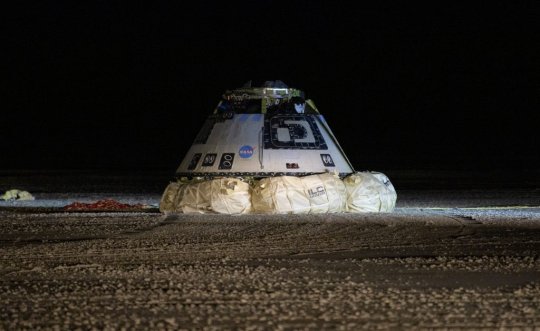
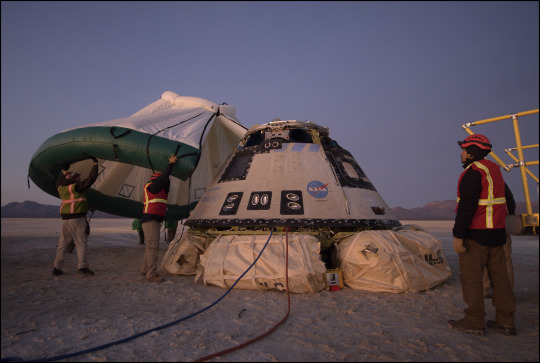
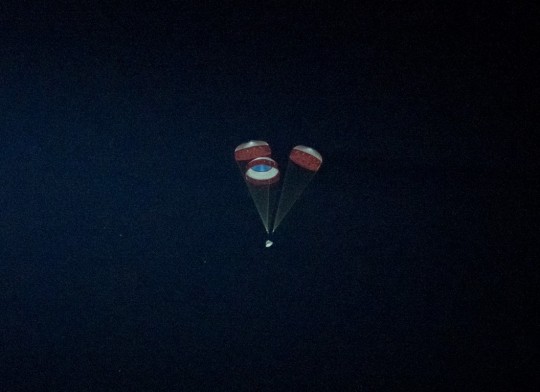

Calypso Starliner returns to earth after shortened Orbital Flight Test (December 22, 2019). Following a shortened, 49 hour, 21 minute flight in space, Boeing’s Starliner Calypso safely landed at the White Sands Space Harbor in New Mexico yesterday, December 22, 2019. A 55 second burn of the capsule’s Orbital Maneuvering and Attitude Control engines occurred at 7:23 am EST, with landing at White Sands 34 minutes later at 7:57 am. Ground and air-based images captured critical events in the capsule’s entry, descent and landing, including the successful deployment of all three drogue and main parachute canopies, heat shield jettison, and airbag deployment. Starliner’s November 4 pad abort test raised concerns when only two of the three parachutes unfurled, though Boeing stated that the capsule could land on two in an emergency without an additional risk to the crew. Recovery operations began once ground teams approached the capsule, installing an inflatable environmental shield and opening the spacecraft’s hatch. This marked the first time Boeing teams have practiced recovery operations on a space-flown capsule, and paves the way for procedures on future crewed flights.  Boeing recovery forces work to secure the Starliner Calypso after a successful landing at White Sands Space Harbor in New Mexico. Photo: NASA. NASA astronaut Suni Williams, who will command the same Starliner capsule that flew the OFT mission in late 2020, was given the honor by Boeing to name the returned capsule. She christened the spacecraft ‘Calypso’ after Oceanic explorer Jacques Cousteau’s famous ship. “A little homage to other explorers and the ships they rode on, I think we are going to call her ‘Calypso.’ Of course I love the ocean,“ said Williams, an avid diver as well as astronaut. "I love what the ocean means to this planet, we would not be this planet without the ocean. There is so much to discover in the ocean and there is so much to discover in space. It just seemed like a natural marriage.” Shortly after her statement, NASA Administrator Jim Bridenstein confirmed Williams’ choice, officially dubbing the capsule Calypso for the first operational Starliner mission, known as PCM-1. Calypso’s landing marks only the second time an orbital vehicle has landed at White Sands Space Harbor. The first was space shuttle Columbia following the STS-3 mission in 1982.  Boeing’s Starliner launches to orbit at 6:36am EST from SLC-41 at Cape Canaveral Space Force Station. Starliner lifted off from SLC-41 atop a ULA Atlas V N22 rocket at 6:36am EST Friday, December 20, from Cape Canaveral Space Force Station in Florida. The capsule was supposed to rendezvous with the International Space Station for a weeklong visit Saturday, but an 11-hour offset error in the Mission Event Timer caused an incorrect orbit to be achieved. This, in turn, depleted too much of Starliner’s fuel reserves, forcing NASA. and Boeing managers to call off the rendezvous. However, in a joint press conference Saturday between NASA and Boeing, managers stated that the remainder of the capsule’s systems were performing flawlessly and that most of the other test objectives of the OFT mission could be completed. Boeing will transport Calypso back to the Commercial Crew and Cargo Processing Facility at Kennedy Space Center within the next two weeks. Starliner will then undergo a thorough analysis of all its hardware to see the effects of orbital flight as well as to understand fully the root cause of the Mission Elapsed Timer anomaly. Boeing expects to have concluded this process by late spring next year, with the Crewed Fight Test to occur sometime over the summer. P/c: NASA.
#Starliner#OFT#Calypso#Boeing#Commercial Crew#NASA#White Sands#White Sands Space Harbor#Commercial Crew Program
86 notes
·
View notes
Photo



Inaugural Starliner mission cut short as computer anomaly nixes ISS rendezvous. (December 21, 2019)
Boeing’s CST-100 Starliner capsule launched on its maiden voyage to space Friday morning, beginning the final phase of testing before flying American astronauts aboard. However, shortly after being deployed from the Atlas V launch vehicle, a problem with the capsule’s Mission Elapsed Timer caused the spacecraft to enter the wrong orbit. This ultimately forced NASA to call off its rendezvous with the International Space Station and return to Earth at the earliest possible opportunity.
Lifting off from Cape Canaveral’s SLC-41 at 6:36AM EST, Starliner’s ascent went according to plan, with separation of the twin AJ-60A solid rocket motors, core stage jettison, and aeroskirt jettison all occurring on schedule.
Fourteen minutes after launch when the Centaur Upper Stage deployed the capsule in orbit is when the anomaly occurred. Starliner’s Mission Elapsed Timer - an onboard computer that controls the spacecraft’s automatic sequence of events – thought the mission was at a different point in space and a different point in the timeline.
This caused the vehicle’s 20 Orbital Maneuvering and Attitude Control (OMAC) engines to fire for the full duration of the 40-second Orbital insertion burn nearly 14 minutes before it was actually supposed to happen.
Controllers at Boeing’s Mission Control Center (BMCC) noticed the error and sent the spacecraft a new set of instructions. However, a brief gap in communications between Starliner and NASA’s Tracking and Data Relay Satellites caused the signal to never be received. Ultimately, Starliner burned 25% more propellant than was intended, forcing NASA and Boeing mission managers to call off Saturday’s planned rendezvous and docking to the International Space Station.
At a postlaunch briefing, NASA Administrator Jim Bridenstein and Boeing’s Jim Chilton stated that Starliner would still perform a shortened orbital shakedown cruise before returning to the White Sands Space Harbor landing site early Sunday morning. Bridenstein stated that further analysis of the Mission Elapsed Timer anomaly would determine whether or not Boeing would need to fly a second uncrewed test before the crewed CFT-1 mission in 2020.

Diagram of the Atlas V N22 launch vehicle. N22 denotes that Atlas will be flying without a payload fairing, two solid rocket boosters, and a dual-engine Centaur Upper Stage. Credit: Boeing.
A unique launch profile and rocket.
Starliner’s ascent to orbit was flawless. It was the first flight of the Atlas V N22 launch vehicle, which featured a number of upgrades to improve the vehicle for Human flight. An Emergency Detection System was installed to autonomously monitor the vehicle’s health during all portions of ascent, and could abort the capsule in the event of a malfunction.
Additionally, a 1.8 meter aeroskirt was installed on the Launch Vehicle Adapter directly aft of the Starliner service module. This better streamlined the rocket’s aerodynamic profile during ascent and kept acoustic loads within safe parameters.
In order to keep acceleration loads – known as G-forces – to a safe level for humans, Boeing required ULA to design a unique ascent profile for the rocket. All Atlas V missions with Starliner will see the vehicle ascend on a much shallower trajectory than normal Atlas V launches. This also means that astronauts are able to abort from the rocket at any portion of the flight, a requirement of NASA’s. To accommodate for the reduction in launch vehicle efficiency caused by this unique trajectory, ULA employed two RL-10 engines on a dual-engine Centaur Upper Stage for the first time. Dual Engine Centaur’s were commonplace on previous Atlas variants, with 166 flights between 1962 and 2004, but have never flown on an Atlas V.
Once Centaur deploys Starliner 14 minutes and 55 seconds after launch, the capsule is just 80 kilometers per hour shy of orbital velocity. Sixteen minutes later, the spacecraft’s 20 OMAC engines fire for 40 seconds to provide the final kick to orbital velocity while simultaneously circularizing the orbit to an altitude of 181 kilometers.
Below, a diagram of the CST-100 Starliner capsule showing the spacecraft’s major components. Credit: Boeing.

Watch a replay of Boeing’s Starliner launch broadcast below:
youtube
P/c: ULA/NASA.
65 notes
·
View notes
Photo






Inaugural Starliner flight arrives at launch pad. (December 18, 2019)
With countdown clocks ticking towards the first test of Boeing’s Starliner capsule, the United Launch Alliance rolled the Atlas V vehicle to SLC-41 Wednesday morning. Starliner’s maiden voyage is scheduled to liftoff on an eight-day shakedown cruise to the International Space Station at 6:36am EST Friday, December 21.
The 45th Space Wing, based at Cape Canaveral Air Force Station, gives an 80% change of acceptable weather conditions for the instantaneous launch window.
Starliner is one of two capsules developed as part of NASA’s Commercial Crew Program, along with SpaceX’s Dragon. Both companies received contracts totaling $6.8 billion in 2014 to develop the first new crewed American spacecraft since the Space Transportation System in the mid-1970s.
Starliner’s Orbital Flight Test marks the second flight of the program and first orbital flight. The capsule tested its abort capabilities during a Pad Abort Test at the White Sands Missile Range November 4. OFT-1 marks the first time an Atlas vehicle has launched a crew-capable spacecraft since the flight of Faith 7 and Mercury-Atlas 9 in May, 1963. It will also mark the first launch of a crew-capable spacecraft from Cape Canaveral Air Force Station since Apollo 8 in December, 1968. The Atlas V will be flying in the new N22 configuration, denoting Starliner replacing a payload fairing, two solid rocket boosters and a dual-engine Centaur upper stage.

P/c: NASA/ULA/Boeing
141 notes
·
View notes
Photo
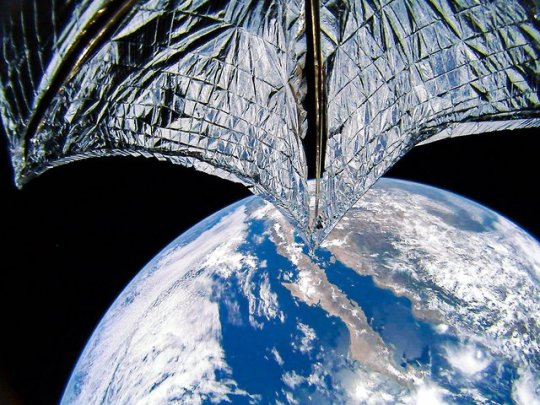


LightSail-2 deploys solar sail, beginning orbital operations (July 23, 2019).
Four weeks after launching on a SpaceX Falcon Heavy rocket from Florida, The Planetary Society’s LightSail-2 spacecraft successfully deployed its solar sail July 23.
Four cobalt-alloy booms unraveled from the main spacecraft bus with the triangular segments of mylar sail material. Once fully unraveled, LightSail 2′s solar sail covers roughly 32 square meters. Deployment occurred at 12:45am EDT over Mexico in range of the mission’s San Luis Obispo, California control center. Two cameras with a 185 degree field of view provided footage of sail deployment and other orbital imagery during the spacecraft’s mission. The spacecraft is orbiting 447 miles above the Earth.

LightSail-2 undergoing preflight sail deployment testing in California in 2016. P/c: The Planetary Society. LightSail-2 is the Planetary Society’s second, larger solar sail testbed spacecraft, having launched the smaller LightSail-1 in 2015. That mission, which launched piggyback with the X-37B spaceplane on an Atlas V rocket, spent 25 days orbiting the Earth and validating the spacecraft’s sail design. Major differences between the two spacecraft include the addition of a reaction wheel to orient the spacecraft and a cluster of mirror’s on the vehicle’s underside that will aid in precise ground-based measurements.
With LightSail-2, the Society hopes to prove that sails could be used for orbit raising and other maneuvers in space, ultimately reducing the cost for cubesats to travel beyond low Earth orbit. Solar Sailing as a technology was first proposed by Planetary Society cofounder Carl Sagan in the late 1970s as a method of deep-space propulsion that utilized photos from the sun as fuel. Much the same way as wind on Earth pushes a ship’s sail, solar sails in space would be propelled by photons from the sun pushing against a large surface area. The Society expects LightSail-2 to remain in orbit for at least a year. As the spacecraft’s apogee, or highest point slowly raises, its perigee, or closest point slowly lowers, eventually causing the sail to plummet into the atmosphere and burn up.
Click here for our coverage of the LightSail program.
P/c: The Planetary Society/Jason Major
59 notes
·
View notes
Photo


China’s iSpace performs first ever Chinese private sector launch.
China’s rapidly expanding aerospace industry achieved a significant milestone Thursday, July 25, with the first ever successful launch of a commercially-developed rocket.
Beijing Interstellar Glory Space Technology Ltd, known as iSpace, launched their Hyperbola-1 rocket at 1pm Chinese Standard Time, or 1am EDT, from the Jiuquan Satellite Launch Center in the Gobi desert. The rocket carried four payloads; three of them were attached to the rocket’s upper stage while the fourth, the CAS-7B radio satellite, was launched for Chinese Central Television. Hyperbola-1 stands more than 20.8 meters tall (65.2 feet) with a diameter of 1.5 meters (4.6 feet). Two of the rocket’s three stages are fueled by solid propellant while the vehicle’s third stage consists of liquid propellant.

This marked the first time a launch vehicle developed by a private company, rather than the state-run China Aerospace Science and Technology Corporation orbited a satellite. Two other Chese NewSpace firms, LandSpace Technology Corporation and OneSpace Technology Co, attempted orbital launches in late 2018 and early 2019 but were unsuccessful.
iSpace plans on using Hyperbola-1 as a testbed for technology needed for Hyperbola-2, a 98-foot, two stage, reusable liquid fueled rocket powered by an in-house developed JD-1 methalox engine. The company hopes this could launch two tons to low Earth orbit by 2021.
Burning liquid Methane and Oxygen, methalox engines are becoming popular in the commercial space industry as the most efficient means of reusable rocket engine technology. SpaceX is developing their methalox Raptor engine for the Starship and Super Heavy launch vehicles.

P/c:
30 notes
·
View notes
Photo
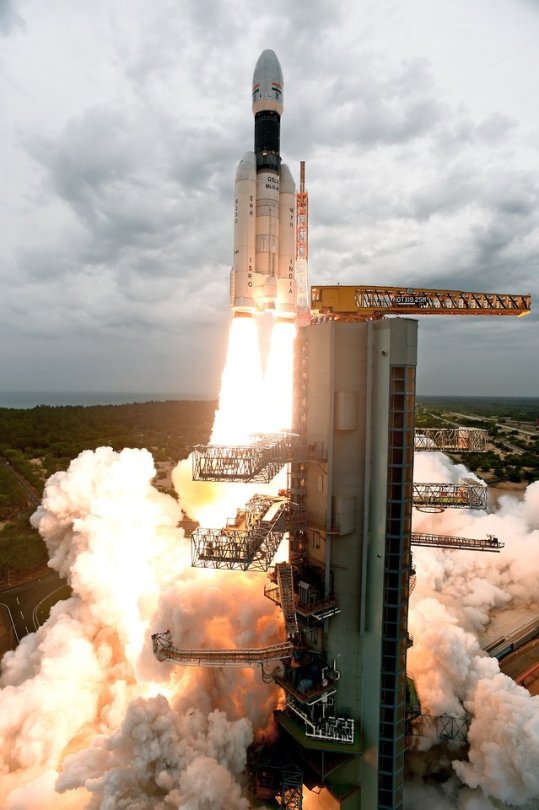
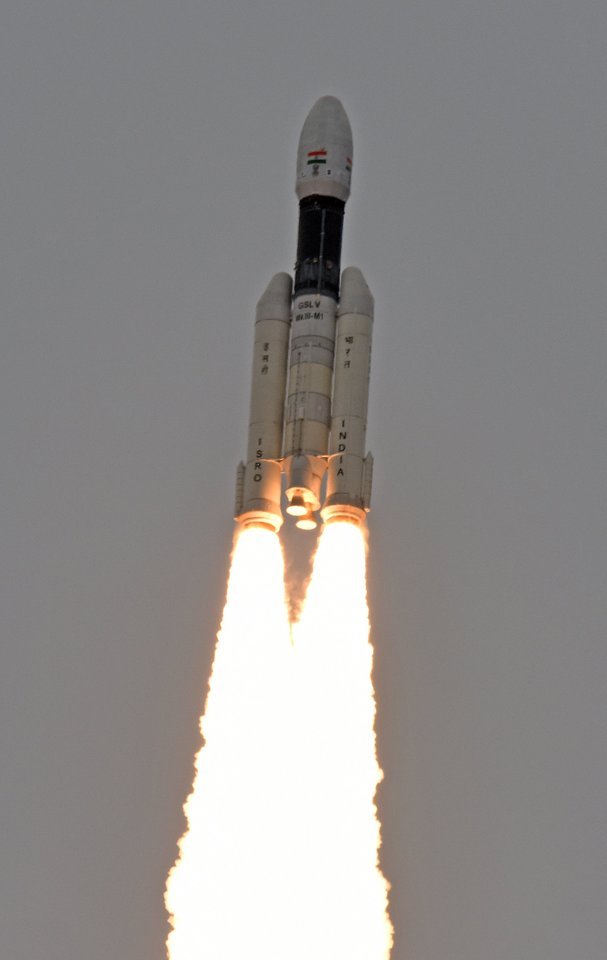
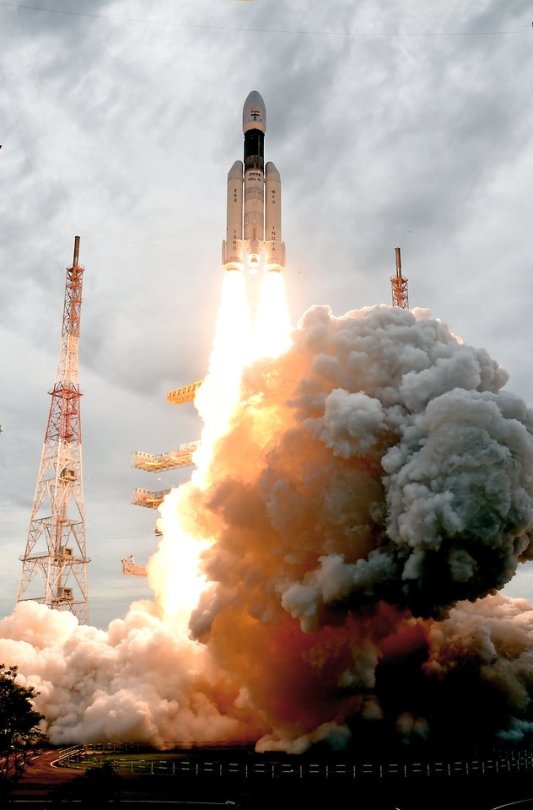
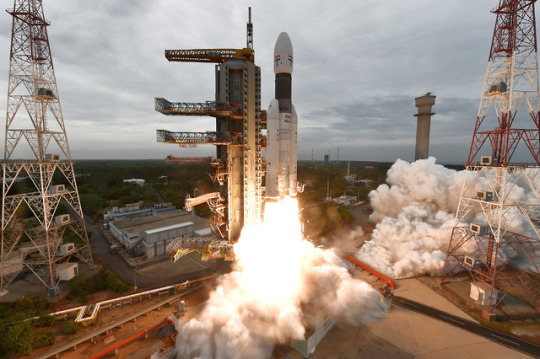
India’s Chandrayaan-2 mission launches on a GSLV Mk III vehicle from the Second Launch Pad at the Satish Dhawan Space Centre, 2:43pm India Standard Time, July 22, 2019. Chandrayaan-2 is India’s first attempt to soft land a rover and lander on the lunar surface, expected on September 7, 2019. P/c: ISRO
93 notes
·
View notes
Photo
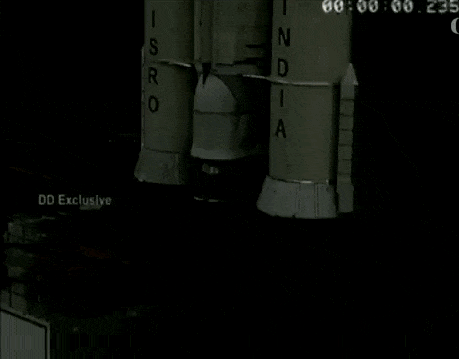

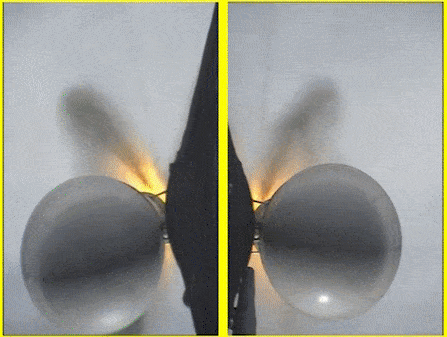

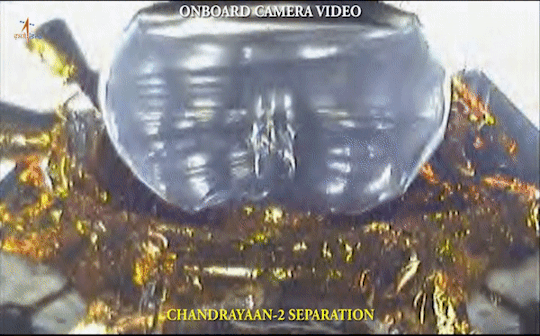
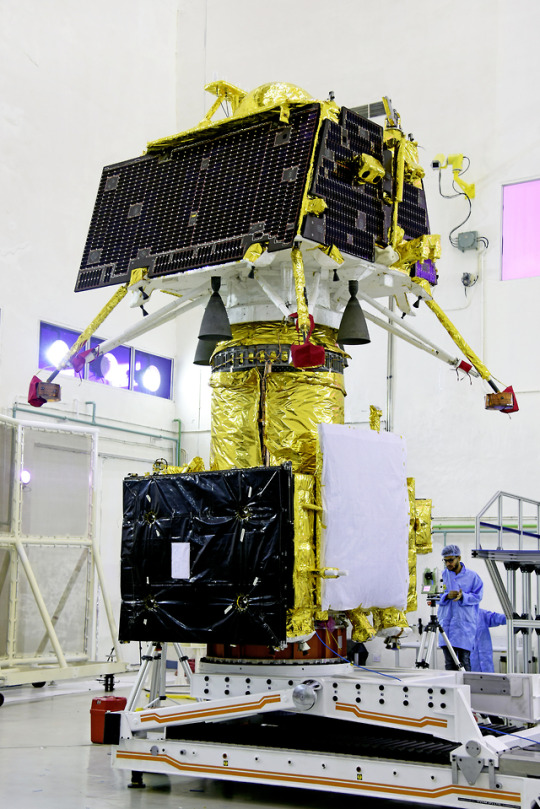
India launches first lunar lander, rover, on Chandrayaan-2 mission (July 22, 2019).
Closing out a week of historic lunar anniversaries, India’s space research organization, ISRO, attempted to make history of their own Monday morning with the launch of the Chandrayaan-2 lunar mission.
The spacecraft is part of the Indian Space Research Organization's, or ISRO, Chandrayaan lunar exploration program, which first saw an orbiter mission launch in 2008.
Chandrayaan-2 is a far more ambitious mission that includes three distinct spacecraft, an orbiter, lander, and rover. If successful, it will mark only the fourth time that a country has softly landed on the moon, behind Russia, the United States, and China.
The 5,244 pound Chandrayaan-2 orbiter will perform orbital measurements and serve as a communications link between ground controllers and the lander. Eight experiments will collect data on the lunar surface and environment, as well as surface mapping. Engineers estimate a one-year lifespan for the orbiter. Named after the founder of Indian space program, the 3,183-pound Vikram lander carries three experiments to measure the Lunar surface, atmosphere, and interior. Additionally, Vikram will transport the mission’s third component, a small, six-wheeled rover named Pragyan. Weighing in at just 60 pounds, Pragyan, which translates to wisdom in Sanskrit, will be India’s first mobile robotic explorer on another world. Its two science experiments will perform laser spectroscopy and X-ray spectrography. Pragyan will travel up to half a kilometer per day with a top speed of 1 centimeter per second. Engineers expect both the Vikram lander and Pragyan rover to operate for one lunar day, or two Earth weeks.
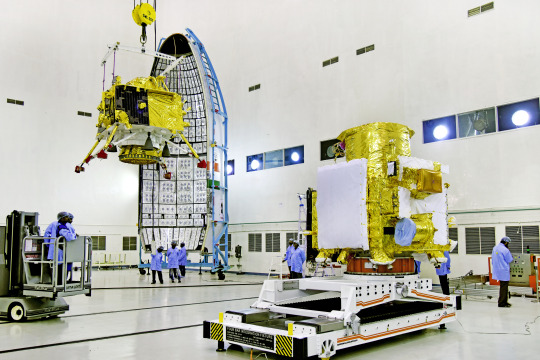
The combined Vikram lander/Pragyan rover, left, is seen integrating with the Chandrayaan-2 orbiter, right at the Satish Dhawan Space Center’s integration building prior to launch. P/c: ISRO A long spiral to the Moon.
Liftoff occurred on the first scientific flight of India’s largest rocket, the GSLV-MkIII, which made its first flight in 2014. Liftoff occurred at 5:13am EDT, or 2:43pm India Standard Time, from the Second Launch Pad of the Satish Dhawan Space Centre in India. Following separation of the rocket’s side boosters, core stage, and payload fairing, Chandrayaan-2 achieved Earth orbit 16 minutes after launch.
Chandaryaan-2 will use a low-energy flight profile for its voyage to the moon that will take up to 44 days to achieve its final orbit. The spacecraft will use its onboard engines to gradually rise its apogee – or furthest point in its orbit – performing a Lunar Orbit Insertion burn 30 days after liftoff. The spacecraft will then spend the next 13 days gradually lowering its apogee to create a circular orbit 100 kilometers above the lunar surface. 48 days after liftoff, the Vikram lander with Pragyan inside is slated to touch down near the lunar south pole. ISRO Chairman Dr. K. Sivan expects the landing to occur on September 7.
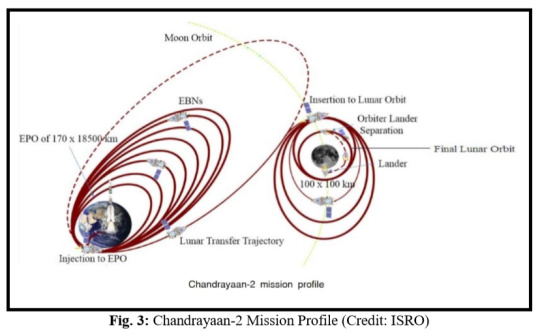
Chandryaan-2 was originally a joint Indian-Russian mission slated to launch in 2011; financial woes, coupled with the high profile failure of the Phobos Grunt Mars mission with Europe ultimately caused Russia to pull out of the project. India’s commitment to complete the missions by themselves pushed the launch to 2018 and further technological hurdles ultimately caused the mission to be delayed to the first half of 2019. Click here to see our GSLV launch vehicle archive.
youtube
P/c: ISRO.
207 notes
·
View notes
Photo


China’s Tiangong-2 laboratory reenters atmosphere. (July 19, 2019)
After nearly three years in orbit, China’s second prototype space station module, Tiangong-2, reentered the Earth’s atmosphere earlier this morning, July 19. Officials from the Chinese Manned Space Engineering Office announced on July 13 that the module would be deorbited on the 19th. The office stated in November 2018 that Tiangong-2 would reenter sometime in 2019. Tiangong-2 used its onboard engines late in the evening of July 18 to lower its orbit, preparing for an early-morning reentry today. Cameras on board the laboratory captured rare footage of the vehicle as it began plummeting through the Earth’s upper atmosphere. The video cuts out shortly after the glowing reaches its highest intensity.
Officials stated that the laboratory reentered the atmosphere at 9:06am EDT in an area of the South Pacific Ocean known as the spacecraft graveyard.
This region of the Pacific is often used for spacecraft and satellites to reenter as it provides a safe, unpopulated area for any surviving fragments to fall in.
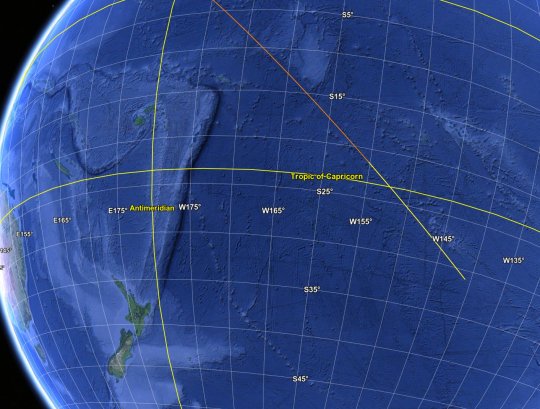
Tiangong-2′s final orbit, visualized by Harvard’s Jonathan McDowell. The yellow slanted line represents the portion of the station’s orbit where it broke apart in the atmosphere. P/c: Jonathan McDowell The 8.6 ton, 34-foot module was launched on a Long March 2F rocket from the Jiuquan Satellite Launch Center September 15, 2016. One month later, the two man Shenzhou-11 crew docked to the station for a 30-day mission, China’s longest crewed flight to date. One of the experiments launched during the crew’s operations was the Banxing-2 microsatellite, which photographed the joint complex in orbit for the first time. China perfected the technologies necessary for orbital operations with the uncrewed Tianzhou-1 mission, an automatic cargo freighter. Launching in April, 2017 on a 60-day mission, Tianzhou-1 developed the procedures necessary for automatic docking and propellant transfer. Both Tiangong modules and the Tianzhou-1 mission were technological pathfinders for the procedures China will use on their larger, modular space station, known as Tianhe. China’s first space station prototype, Tiangong-1, famously made an uncontrolled reentry in April, 2018, following more than six years on orbit. Officials intended for that module to be controlled during its descent but ground controllers lost communications with the craft in March, 2016.
Tiangong-2 spent a total of 1,036 days, 22 hours, 54 minutes and 56 seconds in orbit. For our coverage of Tiangong-2′s mission, click here. Click here for our coverage of Shenzhou-11, and click here for our coverage of the Tianzhou-1 flight.
P/c: Weibo/Andrew Jones
youtube
56 notes
·
View notes
Photo



Following last month’s STP-2 mission, the WorldView-3 satellite captured the two side boosters from SpaceX’s Falcon Heavy rocket at Landing Zone’s 1 and 2. One booster is having its landing legs removed at the perimeter of LZ-1, while the other can be seen at the facility’s main work area to the right of the image.
The STP-2 mission marked the third flight of the Falcon Heavy rocket and the second mission for the vehicle’s side boosters. Liftoff occurred nine miles north of the landing zone’s at Kennedy Space Center’s LC-39A. P/c: Maxar Technologies.
44 notes
·
View notes
Photo
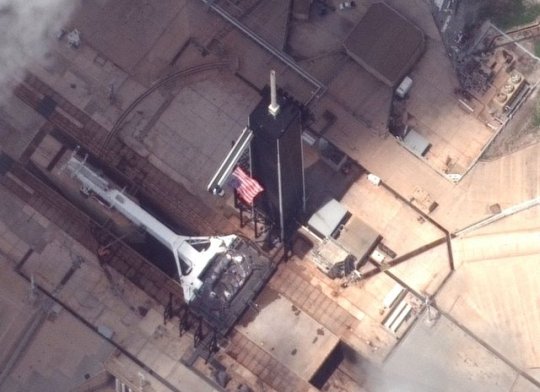

Apollo-era Launch Complex 39 captured from orbit on eve of Apollo 11 golden anniversary (July 10, 2019).
Maxar Technologies' WorldView-3 satellite captured these views of Kennedy Space Center’s Launch Complex 39 Monday, July 8. Both Apollo-era launch pads are now home to different launch vehicles. SpaceX launches their Falcon 9 and Falcon Heavy rockets from LC-39A as well as their Crew Dragon spacecraft. The company hung a giant American flag from their Crew Access Arm in commemoration of the upcoming 50th anniversary of the Apollo 11 mission, which departed for the moon from that very pad. The transporter/erector strongback that the rockets are assembled and transported to the pad on can be seen in the horizontal position adjacent to the service tower. NASA will utilize LC-39B for their Space Launch System, which WorldView-3 captured with the SLS Mobile Launch atop it. The ML was moved from the Vehicle Assembly Building to the pad last week for a final series of validation checks before hosting the first SLS flight in early 2021.
WorldView-3 was roughly 380 miles above the earth when it captured these images. P/c: Maxar Technologies.
60 notes
·
View notes
Photo




NASA’s Ascent Abort 2 launches from LC-46 at Cape Canaveral Air Force Station, July 2, 2019. AA-2 tested the Orion capsule’s Launch Escape System during flight conditions. The 96 foot vehicle was powered by a Northrup Grumman SR-118 solid rocket motor, a surplus first stage from the Peacekeeper ICBM program of the U.S. Air Force. Three minutes after liftoff, the vehicle’s three components impacted the Atlantic ocean roughly ten miles off shore of Cape Canaveral, concluding the flight test.
Click here for our coverage of the AA-2 test.��
P/c: NASA/Tony Gray and Kevin O’Connell
58 notes
·
View notes

